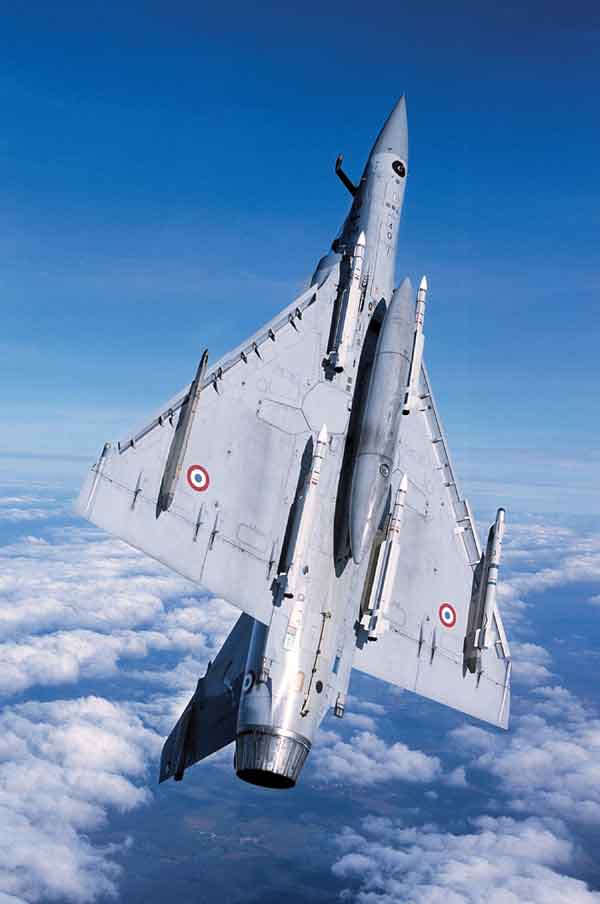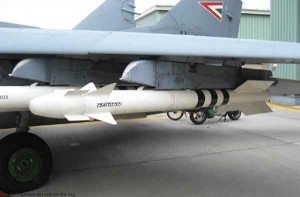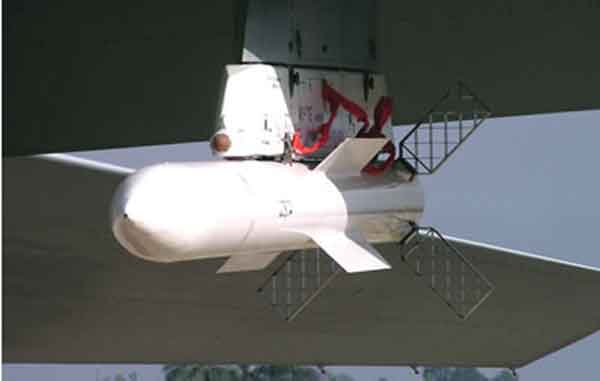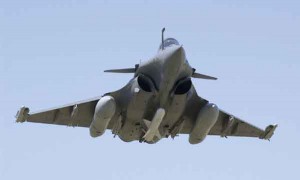Cannons once again found their way into the design of fighter planes. The problem with cannons is that they had to be fired at aerial targets from the astern quarters and any manoeuvring by the target aircraft increases the difficulty for the attacker dramatically reducing its effectiveness. The answer lay in a weapon such as a missile that can be fired immediately on detection of the target visually or by onboard sensors, irrespective of the position of the enemy aircraft relative to the attacker. Design of air-to-air combat missiles is slowly but surely evolving towards ‘fire-and-forget’ capability.
Missiles for Aerial Combat
The Korean War was the testing ground for an all-jet combat environment with the American F-86 Sabre and the Chinese MiG-15 fighter aircraft battling for control of the Korean skies. Aerial combat tactics were similar to that of World War II even though the flight envelope of these jets significantly exceeded those of the famed Spitfire, Hurricane and the Me-109. Air-to-air guided missiles were propounded in the 1950s as the panacea to overcome the challenges of air combat by these faster jets.
The early versions of the Soviet MiG-21 aircraft were designed to carry only guided missiles and had no cannons for air combat. Similarly, in the United States (US) the first models of the F-4 Phantom were armed only with AIM-4 Falcon and the AIM-9 Sidewinder missiles. Fighter tactics were driven by the tactical concepts of directing interceptor aircraft by ground-based radars towards intruding enemy aircraft and engaging them with missiles at beyond visual range. The classical dogfight or close combat of the World War II era then appeared consigned to history. However, the Vietnam and the Yom Kippur Wars re-established the relevance of close combat and the need to have weapons for high altitude interception as well as for dogfight at low and medium altitude.
Air-to-air guided missiles were propounded in the 1950s as the panacea to overcome the challenges of air combat…
Cannons once again found their way into the design of fighter planes. The problem with cannons is that they had to be fired at aerial targets from the astern quarters and any manoeuvring by the target aircraft increases the difficulty for the attacker dramatically reducing its effectiveness. The answer lay in a weapon such as a missile that can be fired immediately on detection of the target visually or by onboard sensors, irrespective of the position of the enemy aircraft relative to the attacker. Design of air-to-air combat missiles is slowly but surely evolving towards ‘fire-and-forget’ capability.
The first time that the Indian Air Force (IAF) fired air-to-air missiles in anger was on the morning of December 04, 1971, by a pair of MiG-21 on Combat Air Patrol (CAP) over Dhaka for the protection of a Hunter aircraft running in at low level to strike Tezgaon airfield in the then East Pakistan. Two F-86 Sabres were scrambled to intercept the approaching strike force. As the Sabres got airborne, they were spotted by the CAP leader who positioned himself behind the Sabres and launched the K-13 missiles. Unfortunately, both the missiles missed the Sabres and the Hunters were left to fend for themselves when they were intercepted. The IAF has come a long way since then.
Generational Change
Air-to-air missiles are categorised by the improvements in each generation of weapon systems. The MiG-21 aircraft of the IAF were armed with the first generation K-13 missiles which had an infra-red seeker with a narrow field of vision optimised for interception at high altitude. However, even a gentle manoeuvre by the target broke the missile lock. The second generation missile had more sensitive seekers and a wider field of vision but the attacking aircraft had still to position itself behind the target. The third generation brought about a significant change and the “all aspect” missiles appeared on the scene. These missiles had better sensors and allowed the attacker greater freedom to fire with the target “side on” but the field of vision was still very narrow. The biggest advantage was that the attacking aircraft did not have to be behind the target when launching the missile. While missiles such as the French Matra Magic-2 and the Russian R-60 claimed “all aspect” capability, they fell short of the fighter pilot’s expectations.
The Russian Vympel R-73 was the first of the fourth generation air-to-air missile and provided a quantum jump in capability. It used an advanced cryogenic seeker to improve the “capture” of the target, was resistant to infrared countermeasures by the target aircraft and the agility of the missile was increased by thrust vectoring. The missile’s field of vision was wider than that of the fighter aircraft’s radar but this dichotomy was corrected by helmet-mounted sights. With these improvements the fourth generation missiles could be used against low flying targets as they had a “look down, shoot down” capability which cut through the ground clutter. The R-73 was later upgraded to an improved version, the R-74M which features fully digital and re-programmable systems for greater versatility.
In 1990, after the unification of East and West Germany, the German Air Force found itself with a large stockpile of R-73 missiles. Performance evaluation in mock combat via-a-vis the Sidewinder AIM-9L showed that the R-73 had been grossly underestimated by the West. The Russian R-73 was a wake-up call for countries that had no access to Russian technology triggering the development of the Sidewinder AIM-9X, the IRIS-T, MICA-IR and the Python IV missiles.
The Russian Vympel R-73 was the first of the fourth generation air-to-air missile…
The fifth generation air-to-air missiles have far better seekers that allow the missile to “see” images rather than detect points of infra-red radiation. The new sensors, coupled with digital signal processing, have improved weapons capability and provide the following benefits:
- Sensors can detect aircraft despite infrared counter-measures
- Provides enhanced firing range and the ability to track small low flying aircraft and UAVs.
- Capability to target vulnerable parts of the aircraft instead of merely homing on to the infrared radiation from the engine exhaust.
The IRIS-T made by the German-led consortium, the Russian R-73M2, the Sidewinder AIM-9X, and the Israeli Python 5 missiles fall into this category.
The technological advances of air-to-air missiles in the last 20 years have made them the primary weapons of modern fighter aircraft. Missiles have been designed for specified ranges, for specific guidance systems and even for specific targets such as the AWACS.
Air-to-air missiles can be clubbed into three distinct categories, highly agile short-range Within Visual Range (WVR), less agile but long range Beyond Visual Range (BVR) and very long BVR missiles. The transition from the third generation to fifth generation missiles has been the result of technological developments which contributed to incremental improvements in capability as under:
- Analogue electronics have been replaced by digital software designs giving the missile a “smart’ capability for guidance algorithms, flight path energy management and better techniques for overcoming counter-measures by the target.
- Replacement of semi-active guidance systems by autonomous active homing systems allowing fighters to break away earlier but more importantly, permitting engagement of multiple targets.
- Seeker technologies have dramatically increased the sensitivity of the missile. The shift from mechanically oscillating seekers to focal plane arrays and the use of CCD TV imaging devices give missiles the ability to neutralise counter-measures and discern targets amidst the clutter.
- Increase in the flight time of medium range missiles with the introduction of solid propellant ramjets.
The international arms bazaar offers fifth generation air-to-air missiles for every mission and the salient features of some of the latest missiles are elaborated on in the succeeding paragraphs.
MICA
Missile d’Interception, de Combat et d’Autodefense or MICA made by MBDA, is in operational service with the French Air Force and Navy on the Mirage 2000 and Rafale and is a dual purpose Within Visual Range (WVR) and also a BVR missile. The BVR version MICA (EM) RF has an Active Radio Frequency seeker and the WVR close combat missile has a dual waveband Passive Imaging Infra Red seeker.
MBDA claims that both types of missiles are fully BVR capable and can track multiple targets at extended ranges with the two inter-operable guidance systems that are optimised to hamper enemy counter-measures. The missile was designed as a multi-aircraft system that could be integrated with any modern fighter and has Lock On Before Launch (LOBL) and Lock On After Launch (LOAL) capability thus giving it a 360-degree envelope. French pilots who fired the MICA-IR over Libya report that its sensor alone is a useful input to their systems, and its passive seeker with LOAL capability means that it can be fired from Beyond Visual Range at enemy aircraft, without generating any warning to the target from its radar warning receivers. India has already ordered 490 missiles as a part of the Mirage 2000 upgrade and this gives MBDA an advantage of having a foot-in-the-door and exploring the possibility of covering India’s market for air-to-air missiles in the coming years.
Rafael Python 5
The Python 4 made by Rafael Advanced Defense Systems, Israel was the first fourth generation missile in production by the West. It was designed to combine the capability of very high sustained G forces during launch and flight with a long duration burn motor to be used in conjunction with a helmet-mounted sight. The Python 5 uses the same aerodynamic airframe inertial navigation system and rocket motor as the Python 4. It has BVR and LOAL capability as also all aspect, all direction including “over the shoulder” attack capability. The missile features an advanced electro-optical imaging infra-red seeker which scans the target area for hostile aircraft and then locks on for the terminal phase. The dual waveband seeker will enables the Python 5 to engage small, low-signature, low-flying targets in adverse weather and cloudy conditions. It has been employed successfully by the Israeli Air Force against UAVs.
Russian Vympel R-73
Vympel NPO, the Soviet design and production facility which is now part of Tactical Missile Corporation also known as TRV designed the R-73 air-to-air missile. The R-73 infra red missile was designed to replace the R-60 close combat missile which was the mainstay of Soviet forces. It radically changed the tactics of air combat due to its ability to “see” targets up to 60 degrees off the missile’s centre line and by allowing pilots to target an aircraft by merely looking at it through a helmet mounted sight. The advanced R-73 missiles have Thrust Vectoring Control (TVC) that offers increased agility. It is claimed that the missile is effective from a range of 300 metres to nearly 30 kms. The R-73 missile has been designed to operate in an all-weather, day/night and jamming environment. It is a fire-and-forget missile with a passive infra-red seeker which locks on before launch. The R-73 entered service in 1982 but subsequent developments of the missile saw the next version, the R-73M with longer range and better Infra Red Counter Counter-measures (IRCCM).
The international arms bazaar offers fifth generation air-to-air missiles for every mission…
The improved version R-74M has fully digital and re-programmable systems thus enlarging the operational envelope. This missile is fully compatible with the MiG-29, upgraded MiG-21, Su-30 MKI and can also be carried by the Russian Mi-24, Mi-28 and Kamov Ka-50 helicopters. Reports indicate that India has about 450 missiles on its inventory.
Russian Vympel R-77
The Russian R-77 is an extended medium range air-to-air missile featuring an active radar seeker to engage multiple targets simultaneously. There are other versions of the missile with infrared and passive instead of the active radar seeker. The missile uses a multi-function Doppler-monopulse active radar seeker. During a short range launch, the missile is launched in a fire-and-forget mode but in a long range launch, the R-77 initially depends on an inertial navigation system with optional in-flight target position updates from the launch aircraft’s sensors. When the missile is about 20 kms from the target, its radar homing head activates and directs it to the target.
The launch aircraft radar system maintains computed target information in case the target breaks the missiles lock-on. The missile has a solid rocket motor with an air breathing ramjet which can accelerate the missile to a speed of 4.5 Mach with an operating range of up to 140 kms. The unique aerodynamics of the missile give it a maximum turn rate of up to 150 degrees per second. The missile is used on most of the Russian Air Force fighter aircraft and was designed to counter the AIM-120 AMRAAM. India and China are the major users of this missile and as per the United Nations Register of Conventional Arms, the IAF has 177 of these missiles.
Raytheon AIM-120 AMRAAM
The Raytheon AIM-120 Advanced Medium Range Air-to-Air Missile was developed as a result of an agreement in the 1980’s between the US and some of the NATO nations to develop air-to-air missiles and share production technology. The US was to develop the next generation medium range missile to replace the AIM-7 Sparrow and the NATO countries would develop the next generation short range missile to replace the AIM-9 Sidewinder. However, the agreement fell through and resulted in the US independently developing the AIM-120 and AIM-9X Sidewinder and Germany along with Italy, Sweden, Greece and Norway developing the IRIS-T missile.
The procurement of 490 MICA air-to-air missiles for the IAF’s soon-to-be-upgraded Mirage-2000 fleet has been approved…
The AIM-120 has an all-weather BVR capability and is effective against low flying targets. The missile is guided to a point where the onboard active radar comes on and directs it till impact with the target. This gives the pilot a ‘fire-and-forget’ capability and the freedom to engage multiple targets or perform evasive manoeuvres while the missile guides itself to the target. The missile has a range of 50 to 75 kms and attains a maximum speed of Mach 4. It is carried by the Eurofighter Typhoon.
IRIS-T
An agreement signed in the 1980s between the US and some of the NATO countries called upon the UK and Germany to produce the AIM-132, a short-range close combat missile to replace the AIM-9 Sidewinder. The programme did not get off the ground as the UK and Germany could not come to an agreement on the design of the airframe particularly the lack of thrust vectoring which was considered essential to improve the flight parameters of the missile. The UK decided to go its own way in the development of the AIM-132 ASRAAM and Germany decided to design a new missile. In 1995, the Germany-led consortium announced the Infra Red Imaging System Thrust Vector (IRIS-T) programme to develop a short range close combat missile to replace the AIM-9 Sidewinder for the NATO. Initially the consortium consisted of Germany, Italy, Sweden, Greece, Canada and Norway. Subsequently, Canada pulled out of the programme but Spain joined in 2003. The German Air Force took the first delivery of the IRIS-T missile in 2005. The missile can be carried by any aircraft that can use the AIM-9 Sidewinder. It is carried by the Eurofighter Typhoon and has been acquired by countries that operate the Lockheed Martin F-16, Boeing F-18 and the Saab Gripen.
AIM-132 ASRAAM
The breakdown of the joint development between Germany and the UK to produce the AIM 132 Advanced Short Range air-to-air missile provided the start point for the independent development of this missile by the UK. The missile is conceptually different from other missiles in that it has been made to engage targets at the maximum range. The missile, also designed to engage the target at close ranges, can be fired in both LOBL as a conventional heat seeker mode or LOAL like a BVR missile. The missile can also be used as an expendable Infra Red Search and Track device. The ASRAAM can be fired “over the shoulder” under high G and high angle of attack flight conditions as long as the pilot can sight the target through the helmet-mounted sight. The missile is used by the Royal Air Force and the Royal Australian Air Force. It is reported that the Jaguars of the IAF may be equipped with the ASRAAM as a replacement for the Magic Matra missiles.
Selection of the French Rafale will see the IAF acquire the fifth generation BVR and close combat missiles for the new fleet…
Air-to-Air Missiles as Surface-to-Air Missiles
A recent trend is the development is the dual use of air-to-air missiles for ground-based defences. The commonality of missile systems reduces the development and manufacturing costs and makes this an attractive option. The US Marine Corps Complementary Low Altitude Weapons System (CLAWS) programme explored the possibility of using the AIM-120 to augment the air defence capability against low flying aircraft and cruise missiles. The AIM-120 is also used by the Norwegian Advanced Surface Missile Systems (NASAMS) as a ground-based surface-to-air missile. The British Common Anti Air Modular Missile is to use the airframe and some components of the ASRAAM infrared missile for modularity and to lower cost. Similarly, the MICA missile can also be used as a short-range surface-to-air missile as the VL MICA and is fired from a truck-mounted box launcher. The Israeli Surface-to-air PYthon 5 and DERby (SPYDER) uses a combination of Python and Derby air-to-air missiles to function as a low-level air defence system.
Prospects for the IAF
The selection of the French Rafale will see the IAF acquire the fifth generation BVR and close combat missiles for the new fleet. The French Rafale carries 8 X Matra MICA air-to-air missiles and the other missile that will be fielded by the IAF in future will be the Defence Research and Development Organisation Astra BVR missile for the Tejas LCA produced by Hindustan Aeronautics Ltd. The single-stage solid fuel Astra is to be integrated with the Sukhoi Su-30 MKI, MiG-29 and the Mirage-2000. The development of the Astra has not been as speedy as the IAF would have liked it to be and the IAF plans to equip the Tejas with the Israeli Rafael Derby BVR missile in the interim with deliveries expected by the end of 2012.
On January 04, 2012, the Cabinet Committee on Security approved the procurement of 490 MICA air-to-air missiles for the soon-to-be-upgraded Mirage-2000 fleet. This procurement provides MBDA the edge in the selection of weapons for the MMRCA fleet.
In addition to the acquisitions by the IAF, the Indian Navy is set to have a fleet of 100 combat fighters as a part of its own, mostly ship-borne assets of some 500 aircraft and helicopters. The Indian Navy has already ordered 45 MiG-29K fighters and another 60 carrier-borne fighter aircraft are likely to be ordered in the future. Various aircraft manufacturers including Boeing, Lockheed Martin, French Dassault, and Swedish Saab have made presentations for the F-18 Super Hornet, F-35 Joint Strike Fighter, Rafale and the Sea Gripen respectively. There is also a naval version of the HAL-manufactured LCA for consideration. Thus, the Indian Navy will have a sizeable requirement of air-to-air missiles for its fleet of combat aircraft.
Over the next decade, the IAF will be one of the world’s single largest buyers of air-to-air missiles. The tactical scenario on India’s Western border with Pakistan calls for the IAF to have a mix of air-to-air missiles which will enable it to intercept low flying aircraft well before they enter Indian airspace. On the Eastern front with China, the IAF needs air-to-air missiles against hostile aircraft and cruise missiles that can mask their approach making use of the mountainous terrain. Fifth generation air-to-air missiles will, undoubtedly, hold the key to the air superiority of the IAF in the coming years.










The Indian Armed forces are ahead of the PAF across the board, Despite all their problems they have better quality equipment and training than the Pakistani forces and it is the Pak Army, which is infamous the world over for its incompetence. It has lost all its wars with India, is routinely defeated by the Taliban, and its forces could not even prevent the humiliation at its premier academy, Abbotabad. Its Generals are basically corrupt and devoid of morals and the rank and file are having morale issues while corrrupt Generals pay money to China and get third rate equipment.
Suggest Pakistan disband its armed forces and only have a police force. For a third rate economy like Pakistan, with illiterate populace, building a modern armed forces is a fools folly.
Dear Sarfaraz, check wikilks and other sources, they all mention IAF is ahead of the PAF in terms of modernization, training, and overall capability. Your PAF is becoming more and more an empty shell more and more dependent on Chinese systems which are of dubious quality. India for instance has the Su-30 MKI, nothing similar is in PAF service. India’s upgraded fighters are far more in number than anything PAF has. As regards LCA, it may be delayed, but it is far better than the JF-17 which Pakistan is purchasing from China, and for dubious reasons of national honor is shamefacedly calling its own. That plane does not even have a full FBW and it has an all metal structure. The PAF is buying an obsolete plane because it is too bankrupt to buy anything more modern. When faced with the IAF, the PAF will be lucky to even survive beyond a few days.
The PAF’s fanboys and their rabid support of this force cannot back up the lack of technology in this force. Furthermore, sources even note that PAF airmen are sabotaging F-16s because they are being used to bomb tribesmen in FATA and hence PAF is worried. I suggest PAF look within to understand why conflict with IAF is a folly.
Many limitations in the article, there is no in production R73M2 or K-74 etc..there is a R73 new variant called RVVMD..
It does not have a new imaging infrared seeker but merely an improved one. Russias lack of investment in FPAs is obvious.
India’s inventory of R-73 and R-77 is much more substantial than mentioned in the article. I’d suggest the author look at SIPRI.se for more details (the arms trade register).